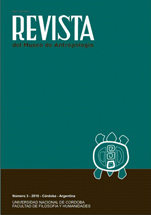Settlement space and visual fields in the archeology of Ambato valley, Catamarca, Argentina
DOI:
https://doi.org/10.31048/1852.4826.v3.n1.5448Keywords:
Aguada, spatial analysis, visibility, structures, locationAbstract
Aguada culture in Ambato valley, Catamarca, acquires a particular manifestation observed spatially by the large number and variety of settlement units by their external characteristics such as location in relation to land and water resources, and its internal characteristics. It attempts to advance in spatial analysis; we had focused on the internal characteristics of the structures built in the Valley, to deepen their relations with their geographical space as a spatial manifestation of the relationship between humans and their environment. The proposal is that through the analysis of visibility, each of the structures, contribute to the knowledge of the factors contributing to its location in the field.Downloads
References
Anchuetz, K., R. Wilshusen and C. L. Scheick. 2001. “An Archæology of Landscapes: Perspectives and Directions”. Journal of Archæological Research, vol. 9, nº 2, pp. 152-197.
Assandri, S. 2001. Procesos de complejización social y organización espacial en el Valle de Ambato, Catamarca. Arqueología Espacial en Iberoamérica, Arturo Ruiz, ed., pp. 67-92. Arqueología Espacial, 23. Teruel: Seminario de Arqueología y Etnología Turolense.
Assandri, S. 2007. Procesos de complejización social y organización espacial en el Valle de Ambato, Catamarca, Argentina. Tesis de Maestría en Arqueología. Universidad Internacional de Andalucía. España. En: http://www.unia.es/nuevo_inf_academica/visualizar_file_Adjunto.asp?ID=3237
Ávila, A. y R. Herrero. 1991. Secuencia estratigráfica 1 del sitio arqueológico Martínez 3, Dpto. Ambato, Catamarca. Publicaciones. Vol. 46. Córdoba. Argentina.
Caro, M. 2002. Desigualdad social y su registro arquitectónico en el sitio arqueológico Piedras Blancas, en Actas de las III Jornadas de Investigación en Ciencias Sociales. http:/ www.ffyh.unc.edu.ar/secretarias/cyt/jor2002/IIIjor.htm
Criado Boado, F. 1989. Megalitos, espacio, pensamiento. Trabajos de Prehistoria. Vol. 46. pp. 75-98. Santiago de Compostela. España Criado Boado, F. 1993 (b). Límites y posibilidades de la Arqueología del Paisaje. Spal.
Criado Boado, F. 1999. Del terreno al espacio: Planteamientos y perspectivas para la Arqueología del Paisaje. Capa 6. Santiago de Compostela. España.
Curtoni, R. 2007. “Arqueología y Paisaje en el Área centro-este de La Pampa.” Tesis Doctoral. Universidad Nacional de La Plata.
Dantas, M. y G. Figueroa. 2009. Terrazas y corrales como espacios integrados de producción agro-pastoril en el Valle de Ambato, Catamarca, Argentina (S. VI-XI d. C.) Relaciones de la Sociedad Argentina de Antropología. XXXIV.
De la Orden, E. A. y A. Quiroga. 1997. Fisiografía y Vegetación de la Cuenca del río de Los Puestos, Departamento Ambato, Catamarca. Revista de Ciencia y Técnica. Vol. IV. Nº 4. Año 3. ISSN Nº 0328-431X.
Fabra, M. 2005 Tecnología cerámica y cambio social en sociedades agrícolas prehispánicas (Valle de Ambato, Catamarca) en La cultura de la Aguada y sus expresiones regionales, pp. 1-14. Eudelar. La Rioja.
García Sanjuán, L. 2005. Introducción al reconocimiento y análisis arqueológico del territorio. Ariel. Prehistoria. Barcelona.
Gillings, M. y D. W. Wheatly. 2001: “Seeing is not believing: unresolved issues in archaeological visibility analysis”, en Slapsak, B. (ed). On the good Use of Geographic Information Systems in Archaeological Landscape studies, Cost Action. G2, 25-36. Bruselas.
Gordillo, I. 1994. Arquitectura y religión en Ambato: organización socio-espacial del ceremonialismo. En Publicaciones 47. Centro de Investigaciones de la Facultad de Filosofía y Humanidades de la Universidad Nacional de Córdoba, Argentina.
Laguens, A. 2007. Contextos materiales de desigualdad social en el valle de Ambato. Revista Española de Antropología Americana 31. Vol. 37, núm. 1, 27-49.
Laguens, A. y M. S. Juez. 2001. Especialización en la manufactura cerámica de pucos Aguada, en Actas del XIII Congreso Nacional de Arqueología Argentina. Vol. 2. Córdoba.
Marconetto, B. 2008. Recursos Forestales y el proceso de diferenciación social en tiempos prehispánicos. Valle de Ambato, Catamarca., Argentina. BAR South America Archaeology Series. Nro. 3. A. Izeta ed. ISBN 978 1 4073 0216 4.
Markgraf, U. 1985. Paleoenviromental history of the last 1000 years in Northwestern Argentina. Zentralhlatt fur geologie und palantologie. 11-12: 1739-1749. Stutgard.
Molinos Molinos, M., Rísquez Cuenca, C., Serrano Peña, J. L. y S. Montilla Pérez. 1994. Un problema de fronteras en la periferia de Tartessos: Las Calañas de Marmolejo. Universidad de Jaén. España
Verdura, B., M. Crezpo, S. Camarasa y O. Heredia. 1974. Informe preliminar sobre una estratigrafía en Los Castillos, Dpto. Ambato, Pcia. de Catamarca. Com. Presentada al III Congreso Nacional de Arqueología. Salta, Argentina
Wheatly, D. 1995. The impact of information technology on the practice of archaeological management.
Wheatly, D.W. y M. Gillings. 2000. “Vision, perception and GIS: developing enriched approaches to the study of archaeological visibility”, en Lock, G. (ed): Beyond the Map, Archaeology and Spatial Technologies, NATO Science Series A, Life Sciencie, Vol. 321. Amsterdam, IOS Press.
Downloads
Published
Issue
Section
License
Those authors who have publications with this Journalaccept the following terms:
a. Authors will retain their copyrights and guarantee the journal the right of first publication of their work, which will be simultaneously subject to the Creative Commons Attribution License (Licencia de reconocimiento de Creative Commons) that allows third parties to share the work as long as its author and his first publication in this journal.
b. Authors may adopt other non-exclusive licensing agreements for the distribution of the version of the published work (eg, deposit it in an institutional electronic file or publish it in a monographic volume) provided that the initial publication in this journal is indicated.
c. Authors are allowed and recommended to disseminate their work on the Internet (eg in institutional telematic archives or on their website) before and during the submission process, which can lead to interesting exchanges and increase citations of the published work. (See The Effect of Open Access - El efecto del acceso abierto)












